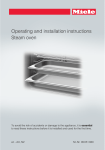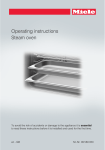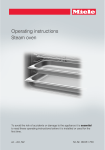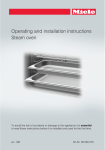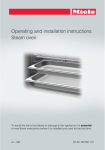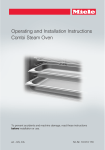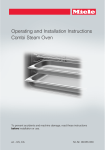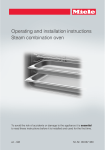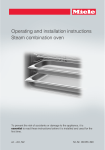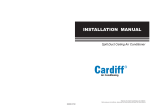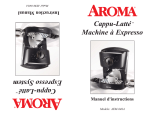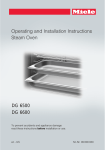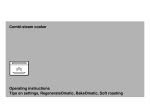Download Miele DGC 5080 XL
Transcript
User instructions
Steam combi oven
DGC 5080 XL
DGC 5085 XL
en - GB
M.-Nr. 07 731 970
Contents
General notes . . . . . . . . . . . . . . . . . . . . . . . . . . . . . . . . . . . . . . . . . . . . . . . . . . . . . 4
General . . . . . . . . . . . . . . . . . . . . . . . . . . . . . . . . . . . . . . . . . . . . . . . . . . . . . . . . . . 4
Cooking containers / Container rack . . . . . . . . . . . . . . . . . . . . . . . . . . . . . . . . . 4
Universal tray / Combi rack . . . . . . . . . . . . . . . . . . . . . . . . . . . . . . . . . . . . . . . . 4
Safety notches . . . . . . . . . . . . . . . . . . . . . . . . . . . . . . . . . . . . . . . . . . . . . . . . . . 5
Your own containers . . . . . . . . . . . . . . . . . . . . . . . . . . . . . . . . . . . . . . . . . . . . . . 5
Steam cooking . . . . . . . . . . . . . . . . . . . . . . . . . . . . . . . . . . . . . . . . . . . . . . . . . . . . . 5
The advantages of cooking with steam . . . . . . . . . . . . . . . . . . . . . . . . . . . . . . . 5
Shelf level . . . . . . . . . . . . . . . . . . . . . . . . . . . . . . . . . . . . . . . . . . . . . . . . . . . . . . 6
Temperature . . . . . . . . . . . . . . . . . . . . . . . . . . . . . . . . . . . . . . . . . . . . . . . . . . . . 6
Cooking duration (time) . . . . . . . . . . . . . . . . . . . . . . . . . . . . . . . . . . . . . . . . . . . 6
Cooking with liquid . . . . . . . . . . . . . . . . . . . . . . . . . . . . . . . . . . . . . . . . . . . . . . 6
Your own recipes . . . . . . . . . . . . . . . . . . . . . . . . . . . . . . . . . . . . . . . . . . . . . . . . 6
Steam cooking / Vegetables . . . . . . . . . . . . . . . . . . . . . . . . . . . . . . . . . . . . . . . . . 7
Steam cooking / Meat . . . . . . . . . . . . . . . . . . . . . . . . . . . . . . . . . . . . . . . . . . . . . 10
Steam cooking / fish . . . . . . . . . . . . . . . . . . . . . . . . . . . . . . . . . . . . . . . . . . . . . . 12
Steam cooking / Universal . . . . . . . . . . . . . . . . . . . . . . . . . . . . . . . . . . . . . . . . . 15
Shellfish . . . . . . . . . . . . . . . . . . . . . . . . . . . . . . . . . . . . . . . . . . . . . . . . . . . . . . . . . 15
Mussels . . . . . . . . . . . . . . . . . . . . . . . . . . . . . . . . . . . . . . . . . . . . . . . . . . . . . . . . . 16
Rice . . . . . . . . . . . . . . . . . . . . . . . . . . . . . . . . . . . . . . . . . . . . . . . . . . . . . . . . . . . . 17
Pasta . . . . . . . . . . . . . . . . . . . . . . . . . . . . . . . . . . . . . . . . . . . . . . . . . . . . . . . . . . . 18
Dumplings . . . . . . . . . . . . . . . . . . . . . . . . . . . . . . . . . . . . . . . . . . . . . . . . . . . . . . . 19
Grain . . . . . . . . . . . . . . . . . . . . . . . . . . . . . . . . . . . . . . . . . . . . . . . . . . . . . . . . . . . 20
Dried pulses. . . . . . . . . . . . . . . . . . . . . . . . . . . . . . . . . . . . . . . . . . . . . . . . . . . . . . 21
Hen’s eggs . . . . . . . . . . . . . . . . . . . . . . . . . . . . . . . . . . . . . . . . . . . . . . . . . . . . . . 22
Fruit . . . . . . . . . . . . . . . . . . . . . . . . . . . . . . . . . . . . . . . . . . . . . . . . . . . . . . . . . . . . 23
Menu cooking . . . . . . . . . . . . . . . . . . . . . . . . . . . . . . . . . . . . . . . . . . . . . . . . . . . 24
Defrosting . . . . . . . . . . . . . . . . . . . . . . . . . . . . . . . . . . . . . . . . . . . . . . . . . . . . . . . 26
Reheating . . . . . . . . . . . . . . . . . . . . . . . . . . . . . . . . . . . . . . . . . . . . . . . . . . . . . . . 29
Bottling . . . . . . . . . . . . . . . . . . . . . . . . . . . . . . . . . . . . . . . . . . . . . . . . . . . . . . . . . 30
Vegetables and fruit. . . . . . . . . . . . . . . . . . . . . . . . . . . . . . . . . . . . . . . . . . . . . . . . 30
Cakes . . . . . . . . . . . . . . . . . . . . . . . . . . . . . . . . . . . . . . . . . . . . . . . . . . . . . . . . . . . 32
Special programmes . . . . . . . . . . . . . . . . . . . . . . . . . . . . . . . . . . . . . . . . . . . . . . 33
Preparing yoghurt . . . . . . . . . . . . . . . . . . . . . . . . . . . . . . . . . . . . . . . . . . . . . . . . . 33
Proving dough . . . . . . . . . . . . . . . . . . . . . . . . . . . . . . . . . . . . . . . . . . . . . . . . . . . . 34
Melting gelatine . . . . . . . . . . . . . . . . . . . . . . . . . . . . . . . . . . . . . . . . . . . . . . . . . . . 34
Melting chocolate . . . . . . . . . . . . . . . . . . . . . . . . . . . . . . . . . . . . . . . . . . . . . . . . . 35
2
Contents
Skinning vegetables and fruit . . . . . . . . . . . . . . . . . . . . . . . . . . . . . . . . . . . . . . . . 36
Apple storage . . . . . . . . . . . . . . . . . . . . . . . . . . . . . . . . . . . . . . . . . . . . . . . . . . . . 37
Blanching . . . . . . . . . . . . . . . . . . . . . . . . . . . . . . . . . . . . . . . . . . . . . . . . . . . . . . . . 37
Steaming onions . . . . . . . . . . . . . . . . . . . . . . . . . . . . . . . . . . . . . . . . . . . . . . . . . . 38
Bacon. . . . . . . . . . . . . . . . . . . . . . . . . . . . . . . . . . . . . . . . . . . . . . . . . . . . . . . . . . . 38
Disinfecting containers . . . . . . . . . . . . . . . . . . . . . . . . . . . . . . . . . . . . . . . . . . . . . 39
Heating flannels . . . . . . . . . . . . . . . . . . . . . . . . . . . . . . . . . . . . . . . . . . . . . . . . . . . 40
Decrystallising honey. . . . . . . . . . . . . . . . . . . . . . . . . . . . . . . . . . . . . . . . . . . . . . . 40
Making jam . . . . . . . . . . . . . . . . . . . . . . . . . . . . . . . . . . . . . . . . . . . . . . . . . . . . . . 41
Food probe . . . . . . . . . . . . . . . . . . . . . . . . . . . . . . . . . . . . . . . . . . . . . . . . . . . . . . 42
Roasting . . . . . . . . . . . . . . . . . . . . . . . . . . . . . . . . . . . . . . . . . . . . . . . . . . . . . . . . 46
Roasting chart . . . . . . . . . . . . . . . . . . . . . . . . . . . . . . . . . . . . . . . . . . . . . . . . . . . . 48
Baking . . . . . . . . . . . . . . . . . . . . . . . . . . . . . . . . . . . . . . . . . . . . . . . . . . . . . . . . . . 50
Fan plus . . . . . . . . . . . . . . . . . . . . . . . . . . . . . . . . . . . . . . . . . . . . . . . . . . . . . . . . . 50
Conventional heat . . . . . . . . . . . . . . . . . . . . . . . . . . . . . . . . . . . . . . . . . . . . . . . . . 50
Top heat . . . . . . . . . . . . . . . . . . . . . . . . . . . . . . . . . . . . . . . . . . . . . . . . . . . . . . . . 50
Bottom heat . . . . . . . . . . . . . . . . . . . . . . . . . . . . . . . . . . . . . . . . . . . . . . . . . . . . . . 50
Intensive bake . . . . . . . . . . . . . . . . . . . . . . . . . . . . . . . . . . . . . . . . . . . . . . . . . . . . 50
Cake plus . . . . . . . . . . . . . . . . . . . . . . . . . . . . . . . . . . . . . . . . . . . . . . . . . . . . . . . 50
Combination mode . . . . . . . . . . . . . . . . . . . . . . . . . . . . . . . . . . . . . . . . . . . . . . . . 51
Baking tips . . . . . . . . . . . . . . . . . . . . . . . . . . . . . . . . . . . . . . . . . . . . . . . . . . . . . . . 52
Baking chart. . . . . . . . . . . . . . . . . . . . . . . . . . . . . . . . . . . . . . . . . . . . . . . . . . . . . . 54
Grilling . . . . . . . . . . . . . . . . . . . . . . . . . . . . . . . . . . . . . . . . . . . . . . . . . . . . . . . . . 57
Grilling chart . . . . . . . . . . . . . . . . . . . . . . . . . . . . . . . . . . . . . . . . . . . . . . . . . . . . . 59
Drying food . . . . . . . . . . . . . . . . . . . . . . . . . . . . . . . . . . . . . . . . . . . . . . . . . . . . . . 61
3
General notes
Please read through the operating instructions carefully to
help you familiarise yourself with the appliance and also for
information on how to use the different functions.
This section contains general information. You will find more
detailed information about particular foods and how to cook
them in the other sections.
General
Cooking containers / Container rack
The appliance is supplied with stainless steel cooking
containers and a container rack. It is best to use perforated
containers for steam cooking. The steam can reach the food
from all sides and the food is cooked evenly.
Universal tray / Combi rack
Use the universal tray with the rack on top when grilling, for
example. Place the tray between the rails of one of the shelf
runners and the rack will fit on top automatically. Remove
both the tray and the rack together to prevent it tipping.
Do not use the combi rack in steam cooking and defrosting
modes.
4
General notes
Safety notches
The universal tray, combi rack and container rack have
non-tip safety notches which prevent them being pulled right
out when they only need to be partially pulled out. They need
to be lifted in order to remove them from the oven.
Your own containers
You can also use your own containers. However, please note
the following:
– The container must be suitable for using in an oven and
must be steam resistant. With plastic containers please
check with the manufacturer that they are suitable for use
in a combi steam oven.
– Containers made from silicone should only be used with
the Fan plus, Conventional heat, Cake plus, Top heat and
Bottom heat functions as they are not steam resistant.
– Thick walled containers are not very suitable for using with
steam. The thick walls do not conduct heat well and as a
result cooking durations will be considerably longer than
those given in the charts.
– Place the cooking containers on the rack or in a cooking
container, not on the oven floor.
– Ensure that there is a gap of at least 3 cm between the
upper rim of the container and the top of the cooking
compartment to allow sufficient of steam to reach the food.
Steam cooking
The advantages of cooking with steam
Almost all vitamins and minerals are retained as the food is
not immersed in water.
Cooking with steam also retains the true taste of the food
better than conventional cooking. We therefore recommend
seasoning the food after it has been cooked. Food retains its
fresh, orginal colour.
5
General notes
Shelf level
You can select any shelf level. You can also cook on several
levels at the same time. This will not alter the cooking
duration.
Temperature
A maximum temperature of 100 °C is reached when steam
cooking is taking place. Most types of food will cook at this
temperature. Some more delicate types of food, such as soft
fruit, must be cooked at lower temperatures as otherwise they
will burst. More information is given in the relevant section.
Cooking duration (time)
In general, the cooking durations for cooking with steam are
the same as for cooking food in a saucepan. More
information about any factors which may affect the cooking
duration is given in the relevant sections.
The quantity of food does not affect the cooking duration. 1
kg of potatoes will take the same time to cook as 500 g.
The cooking durations given in the charts are guidelines only.
We recommend selecting the shorter cooking duration
quoted. If food is not cooked sufficiently after the shorter time
it can be put back in the oven and cooked for longer.
Cooking with liquid
When cooking with liquid only fill the cooking container 2/3 full
to prevent the liquid spilling when the cooking container is
removed from the oven.
Your own recipes
Food and recipes which are prepared in pot or a pan can
also be cooked using steam. The cooking durations will be
the same. Please note that food will not be browned when
cooking with steam.
6
Steam cooking / Vegetables
Fresh vegetables
Prepare fresh vegetables in the usual way, i.e. wash, clean
and cut them up.
Deep frozen vegetables
Frozen vegetables do not need to be defrosted beforehand,
unless the vegetables have been frozen together in a block.
Frozen and fresh vegetables which take the same length of
time to cook can be cooked together.
If vegetables have frozen together in clumps, break these up
before cooking with steam. Follow the manufacturer's
instructions on the packaging regarding cooking duration.
Cooking containers
Food such as peas or asparagus spears, which have little or
no space between them will take longer to cook because the
steam has less space to work in. For an even result, it is best
to use a shallow container for these types of foods, and only
fill it 3-5 cm deep. When cooking large quantities divide the
food between 2 or 3 shallow cooking containers rather than
using one deep one.
Different types of vegetables which take the same length of
time to cook can be cooked together.
Use solid containers for vegetables which are cooked in
liquid such as cabbage.
Shelf level
When cooking vegetables with a distinctive colour (e.g
beetroot) in a perforated container, do not place any other
containers underneath to avoid any colour transfer.
Duration
As with conventional methods, when cooking vegetables with
steam the cooking duration will depend on the size and also
whether you want the vegetables to be al dente or soft / well
done. Example:
waxy potatoes, cut into quarters = approx. 18 minutes
waxy potatoes, cut in half = approx. 22 minutes
Brussels sprouts, large, al dente = approx. 12 minutes
Brussels sprouts, small, soft = approx. 12 minutes
7
Steam cooking / Vegetables
Function (depending on model)
Steam cooking / Vegetables
Cook vegetables #
Steam cooking / Universal
Cook universal !
Settings
Temperature in °C
Duration in minutes
Artichokes
100
35 - 40
Beetroot, whole
100
40 - 50
Black salsify, whole
100
8 - 12
Broccoli florets
100
4-8
Brussels sprouts
100
12 - 16
Carrots, sliced
100
6 - 10
Cauliflower florets
100
6 - 10
Cauliflower, whole
100
20 - 45
Celeriac, cut into batons
100
8 - 10
Celery stalks
100
7 - 10
Chicory
100
3-5
Chinese cabbage
100
4-6
Corn on the cob
100
10 - 25
Courgettes, sliced
100
2-4
Curly kale, chopped
100
20 - 30
Fennel, cut into strips
100
6 - 10
Fennel, halved
100
12 - 16
Green asparagus
100
7 - 12
Green beans
100
8 - 12
Kohlrabi, cut into batons
100
6 - 10
8
Steam cooking / Vegetables
Temperature in °C
Duration in minutes
Leeks, halved lengthwise
100
8 - 12
Leeks, sliced
100
4-8
New potatoes
100
25 - 40
Peas
100
3-8
Peppers, cut into strips
100
2-6
Potatoes, peeled and halved
100
20 - 40
Pumpkin, diced
100
3-6
Red cabbage, chopped
100
20 - 30
Romanesco florets
100
6 - 10
Romanesco, whole
100
15 - 30
Savoy cabbage, chopped
100
6 - 10
Spinach
100
2-4
Spring cabbage, chopped
100
8 - 10
Sugar snap peas
100
3-8
Swede, batons/diced
100
7 - 12
Swiss chard
100
2-6
White asparagus
100
10 - 16
White cabbage, chopped
100
15 - 20
The cooking durations given in the chart are guidelines for fresh vegetables. We
recommend selecting the shorter cooking duration quoted. If food is not cooked
sufficiently after the shorter time it can be put back in the oven and cooked for
longer.
9
Steam cooking / Meat
Fresh meat
Prepare the meat in the usual way.
Deep frozen meat
Meat should be thoroughly defrosted beforehand (see
"Defrosting").
Preparation
For meat which needs to be seared before being cooked,
e.g. stewing steak, sear the meat in a pan on the hob. Then
place it in the oven to cook it with steam.
Temperature
Sausages should be cooked with steam at a temperature of
90 °C. They will burst at higher temperatures.
Duration
The cooking duration depends on the thickness and
consistency of the food and not the weight. The thicker the
food, the longer the cooking duration. A 10 cm thick piece of
meat weighing 500 g will take longer to cook than a 5 cm
thick piece of meat weighing 500 g.
The cooking duration for sausages is between 2 and
10 minutes depending on thickness.
Useful tips
Use a perforated container to retain the flavours when
cooking meat. Place a solid container underneath to catch
the juices.
You can use these to make a gravy or freeze them for later
use.
Prime beef topside is particularly successful when cooked in
stock or gravy at 90 °C.
10
Steam cooking / Meat
Boiling fowl, beef flank, meat, ribs and meat bones can be
used to make stock. Place the meat together with some
mixed vegetables in a solid cooking container and add cold
water. Cook at 100 °C for 60 to 90 minutes. The longer the
cooking duration, the stronger the stock.
Function (depending on model)
Steam cooking / Meat
Cook meat %
Steam Cooking / Universal
Cook universal !
Settings
Temperature
in °C
Duration
in minutes
Beef stew
100
40 - 50
Boiling fowl
100
50 - 60
Chicken breast fillet
100
8 - 10
Flank
100
60 - 70
Gammon steaks
100
6-8
Knuckle
100
90 - 95
Lamb ragout
100
12 - 16
Poularde
100
50 - 60
Prime beef topside
90
120 - 180
Turkey escalopes
100
4-6
Turkey roulade
100
12 - 15
Veal cutlets
100
3-4
The cooking durations given in the charts are guidelines only.
We recommend selecting the shorter cooking duration
quoted. If food is not cooked sufficiently after the shorter time
it can be put back in the oven and cooked for longer.
11
Steam cooking / fish
Fresh fish
Prepare fresh fish in the usual way, i.e. clean, gut and fillet.
Deep frozen fish
Defrost frozen fish (see "Defrosting").
Preparation
Add some lemon or lime juice to fish before cooking. The
citric juice makes the flesh stay firm.
It is not necessary to season fish when cooking with steam as
this method retains the minerals which give the fish its unique
flavour.
Cooking containers
If using a perforated container to cook fish, grease it
beforehand.
Shelf level
When cooking fish in a perforated container we recommend
placing the universal tray on the shelf below to avoid any
transfer of flavour to other food due to liquid dripping through
the perforations and also avoid odour building up in the
appliance.
Temperature
85 °C
For gently cooking delicate types of fish, such as sole.
100 °C
For cooking firmer types of fish, e.g. cod and salmon.
Also for cooking fish in sauce or stock.
12
Steam cooking / fish
Duration
The cooking duration depends on the thickness and the
texture of the fish, and not on the weight. The thicker the fish,
the longer the cooking duration. A 3 cm thick piece of fish
weighing 500 g will take longer to cook than a 2 cm thick
piece of fish weighing 500 g.
The longer fish cooks, the firmer its flesh will become. Use the
cooking durations given in the chart.
If you find that the fish is not cooked sufficiently only cook it
for a few minutes more.
When cooking fish in sauce or stock, we recommend that you
increase the cooking duration quoted by a few minutes.
Useful tips
Adding herbs and spices, such as dill, will help bring out the
full flavour of the fish.
Cook large fish in the swimming position. To help maintain the
shape of the fish, place a small cup or similar upside down in
the cooking container, and arrange the fish bellyside down
over the cup.
You can use any fish scraps, e.g. fish heads, bones, tails etc
to make a fish stock. Place the fish scraps together with
some mixed vegetables in a solid cooking container and add
cold water. Cook at 100 °C for 60 to 90 minutes. The longer
the cooking duration, the stronger the stock.
Blue fish is fish which is cooked in water and vinegar. It is
important not to damage the skin of the fish. This method is
suitable for cooking carp, trout, tench, eel and salmon.
13
Steam cooking / fish
Function (depending on model)
Steam cooking /Fish
Cook fish $
Steam cooking / Universal
Cook universal !
Settings
Temperature in °C
Duration in minutes
Atlantic cod fillet
100
4-6
Carp, 1.5 kg
100
18 - 25
Coral cod, whole
85
15 - 20
Eel
100
5-7
Haddock fillet
100
6-8
Halibut fillet
85
3-5
Monk fish fillet
85
8 - 10
Nile perch fillet
100
4-8
Pangasius fillet
85
3-5
Perch fillet
85
6-8
Pikeperch fillet
85
5-7
Plaice fillet
85
5-7
Rose fish fillet
100
6-8
Salmon fillet
100
4-8
Salmon trout
100
13 - 15
Seabream fillet
85
3-5
Shark steak
90
5-7
Sole fillet
85
2-3
Trout, 250 g
90
10 - 12
Tuna fish steak
100
3-5
Turbot fillet
85
3-5
The cooking durations given in the chart are guidelines for fresh fish. We
recommend selecting the shorter cooking duration quoted. If food is not cooked
sufficiently after the shorter time it can be put back in the oven and cooked some
more.
14
Steam cooking / Universal
Shellfish
Preparation
Defrost frozen shellfish before cooking with steam.
Peel, remove and discard the intestines, and then wash the
shellfish.
Cooking containers
Use perforated containers to cook shellfish and grease them
beforehand.
Duration
The longer shellfish are cooked, the tougher they become.
Use the cooking durations given in the chart.
When cooking shellfish in sauce or stock, we recommend that
you increase the cooking duration quoted by a few minutes.
Function (depending on model)
Steam Cooking / Universal
Cook universal !
Settings
Temperature in °C Duration in minutes
Crevettes
90
3
King Prawns
90
4
Large shrimps
90
3
Lobster tails
95
10 - 15
Prawns
90
3
Small shrimps
90
3
15
Steam cooking / Universal
Mussels
Fresh mussels
,Only cook mussels which are closed.
N.B. Do not eat mussels which have not opened after
being cooked. Danger of food poisoning.
Steep fresh mussels in water for a few hours before cooking
to rinse out any sand. Then scrub the mussels thoroughly to
clean them.
Deep frozen mussels
Defrost frozen mussels before cooking.
Duration
The longer mussels are cooked, the tougher they become.
Use the cooking durations given in the chart.
Function (depending on model)
Steam Cooking / Universal
Cook universal !
Settings
16
Temperature
in °C
Duration
in minutes
Barnacles
100
2
Bearded mussels
100
12
Cockles
100
2
Pilgrim scallops
90
5
Razor clams
100
2-4
Venus mussels
100
4
Steam cooking / Universal
Rice
Rice swells when cooked and needs to be cooked in liquid.
The proportion of rice to liquid will vary depending on the
type of rice.
The rice absorbs all the liquid and so none of the nutrients
are lost.
Function (depending on model)
Steam Cooking / Universal
Cook universal !
Settings
Ratio
Rice : Liquid
Temperature
in °C
Duration
in minutes
1:1
100
15
1 : 1.5
100
35 - 40
Parboiled rice
1:1
100
20
Round grain rice
1:2
100
25
Wild rice
1:1
100
35 - 40
Basmati rice
Brown rice
17
Steam cooking / Universal
Pasta
Dry pasta
Dry pasta swells when it is cooked and needs to be cooked
in liquid. The liquid must cover the pasta. Using hot liquid
gives better results.
Settings for dry pasta
Reduce the cooking time recommended by the manufacturer
on the packaging by about 1/3 as the pasta will start to swell
during the heating up time.
Fresh pasta
Fresh pasta, such as you can buy from the supermarket
chilled counter, does not need to absorb water. Cook fresh
pasta in a perforated container.
Separate any pieces of pasta which have stuck together and
spread them out in the cooking container.
Function (depending on model)
Steam Cooking / Universal
Cook universal !
Settings for fresh pasta
18
Temperature in °C
Duration in minutes
Gnocchi
100
2
Ravioli
100
2
Tortellini
100
2
Steam cooking / Universal
Dumplings
Ready made boil-in-the-bag dumplings need to be well
covered with water as otherwise they can fall apart. This is
because even although they have been soaked in water
beforehand they will not absorb enough moisture.
Cook fresh dumplings in a greased, perforated container.
Function (depending on model)
Steam Cooking / Universal
Cook universal !
Settings
Temperature
in °C
Duration
in minutes
Boil-in-the-bag bread dumplings
100
15 - 18
Boil-in-the-bag potato dumplings
100
15 - 18
Yeast dumplings
100
12 - 15
19
Steam cooking / Universal
Grain
Grain swells during cooking and needs to be cooked in
liquid. The proportion of grain to liquid will vary depending on
the type of grain.
Grain can be cooked whole or cracked.
Function (depending on model)
Steam Cooking / Universal
Cook universal !
Settings
20
Ratio
Grain : Liquid
Temperature
in °C
Duration
in minutes
Amaranth
1:2
100
40
Bulgur
1:1
100
10
Green spelt,
cracked
1:1
100
10
Green spelt, whole
1:1
100
16 - 18
Millet, whole
1:1
100
30 - 35
Oats, cracked
1:1
100
10
Oats, whole
1:1
100
16 - 18
Polenta
1:3
100
10
Quinoa
1:2
100
10
Rye, cracked
1:1
100
10
Rye, whole
1:1
100
30 - 35
Wheat, cracked
1:1
100
10
Wheat, whole
1:1
100
20 - 25
Steam cooking / Universal
Dried pulses
Pulses swell during cooking and need to be cooked in liquid.
The ratio of pulses to liquid should be 1:3.
Soak pulses for at least 10 hours in cold water before
cooking. Soaking makes the pulses more digestible and
shortens the cooking duration required.
Exception: Lentils do not need to be soaked before cooking.
Function (depending on model)
Steam Cooking / Universal
Cook universal !
Settings
Temperature
Duration in minutes
in °C
Pre-soaked
Not pre-soaked
Black beans
100
60
120
Borlotti beans
100
55
110
Haricot beans
100
25 - 30
60
Kidney beans
100
55
110
Pinto beans
100
60
120
Brown lentils
100
-
15 - 20
Red lentils
100
-
8
Green peas
100
20 - 25
40 - 80
Yellow split peas
100
20 - 40
40 - 80
Beans
Lentils
Peas
21
Steam cooking / Universal
Hen’s eggs
Use a perforated container to prepare boiled eggs in the
steam oven.
The eggs do not need to be pierced before cooking as they
are gradually warmed during the heating up phase and so do
not burst when they are cooked with steam.
Plunge the eggs into cold water after cooking to stop them
from continuing to cook.
When using a solid container for preparing egg dishes,
remember to grease it first.
Function (depending on model)
Steam Cooking / Universal
Cook universal !
Settings
22
Temperature
in °C
Duration
in minutes
Eggs medium size,
soft boiled
100
4-5
Eggs medium size,
medium boiled
100
5-7
Eggs medium size,
hard boiled
100
8 - 10
Steam cooking / Universal
Fruit
Cook delicate types of fruit, the skin of which burst easily
(e.g. apricots) at 90 °C only.
Cook fruit in a solid container so that none of the juice is lost.
If you wish to cook fruit in a perforated container, place a
solid container directly underneath it to collect the juice.
Useful tip
You can use the juice which has collected in the solid
container to make a glaze for a fruit flan.
Function (depending on model)
Steam Cooking / Universal
Cook universal !
Settings
Temperature in °C Duration in minutes
Apple pieces
100
3-5
Apricot halves
90
2-4
Cherries
90
2-4
Gooseberries
90
2-4
Pear chunks
100
3-5
Plums
100
2-4
Rhubarb
100
2-3
Sour cherries
90
2-4
23
Menu cooking
You can use the steam oven to cook a whole meal containing
types of food which have different cooking durations, e.g. fish
fillet with rice and broccoli. The food which has the longest
cooking duration is placed in the steam oven first and then
each subsequent dish is placed in the oven at the
appropriate time so that the whole meal is ready at the same
time.
Shelf level
When cooking fish or food with a distinctive colour (e.g.
beetroot), do not place any other cooking containers directly
underneath to avoid any transfer of flavour or colour to other
food. Depending on their size, several containers can be
used on the same level.
Temperature
Whole meals should be cooked at a temperature of 100 °C as
this is the temperature required to cook the majority of foods.
Do not cook a whole meal at the lowest temperature when
different temperatures are required for different types of food,
e.g. 85 °C for seabream and 100 °C for potatoes.
If the recommended cooking temperature for the food is
85 °C for example, try cooking it at 100 °C and testing the
result. Some delicate types of fish with a soft structure, e.g.
sole and plaice will become very firm when cooked at 100 °C.
Duration
If you are increasing the recommended temperature, shorten
the cooking duration by approx. 1/3.
Function (depending on model)
Steam cooking / Universal
Cook universal !
Settings
Temperature: 100 °C
Duration: will depend on the type of food
24
Menu cooking
Example
Rice
Fish fillet
Broccoli
20 minutes
6 minutes
4 minutes
20 minutes - 6 minutes = 14 minutes (1st cooking duration:
rice)
6 minutes - 4 minutes = 2 minutes (2nd cooking duration: fish
fillet)
Remaining time = 4 minutes (3rd cooking duration: broccoli)
Duration
20 min - rice
6 min - fish fillet
4 min broccoli
Setting
14 min
2 min
4 min
^ Place the rice in the oven first.
^ Set the first cooking duration: 14 minutes.
^ After 14 minutes, place the fish in the oven.
^ Set the first cooking duration: 2 minutes.
^ After 2 minutes, place the broccoli in the oven.
^ Set the third cooking duration: 4 minutes.
25
Defrosting
It is much quicker to defrost items in the steam oven than at
room temperature.
Temperature
60 °C is the best temperature for defrosting.
Exceptions:
50 °C for minced meat and game.
Before and after defrosting
Remove all packaging before defrosting.
Exceptions:
Leave bread, biscuits and cakes in their packaging as
otherwise they will absorb moisture and become soft.
Allow defrosted food to stand at room temperature after
removing it from the oven. The standing time is necessary to
allow the even distribution of heat.
Cooking container
Use a perforated container when defrosting food which will
drip, such as poultry.
,It is particulary important to observe food hygiene
rules when defrosting poultry. Do not use the liquid from
defrosted poultry. Pour it away and wash the container,
the sink and your hands. Danger of salmonella poisoning.
Useful tips
Fish does not need to be fully defrosted before cooking.
Defrost so that the surface is sufficiently thawed to take herbs
and seasoning. Depending on the thickness of the fish, 2 - 5
minutes should be enough.
When defrosting food which has frozen together, e.g. berries,
chops, fish fillets etc. separate it about half-way through the
defrosting time.
Do not refreeze food once it has thawed.
Defrost frozen pre-cooked meals according to the
manufacturer's instructions.
26
Defrosting
Function
Defrost P
Settings
Food to be
defrosted
Weight
in g
Temperature Defrosting
in °C
duration
in minutes
Standing time
in minutes
Dairy products
Cheese slices
125
60
15
10
Cream
250
60
20 - 25
10 - 15
Quark
250
60
20 - 25
10 - 15
Soft cheese
100
60
15
10 - 15
Apple pieces
250
60
20 - 25
10 - 15
Apple sauce
250
60
20 - 25
10 - 15
Apricots
500
60
25 - 28
15 - 20
Cherries
150
60
15
10 - 15
Gooseberries
250
60
20 - 22
10 - 15
Peaches
500
60
25 - 28
15 - 20
Plums
250
60
20 - 25
10 - 15
Raspberries /
Blackcurrants
300
60
8
10 - 12
Strawberries
300
60
8 - 10
10 - 12
300
60
20 - 25
10 - 15
Lobster
300
60
25 - 30
10 - 15
Small shrimps
300
60
4-6
5
Trout
500
60
15 - 18
10 - 15
Fruit
Vegetables
Frozen in a block
Fish
27
Defrosting
Food to be
defrosted
Weight
in g
Temperature Defrosting
in °C
duration
in minutes
Standing time
in minutes
Meat
Cutlets / chops /
sausages
800
60
25 - 35
15 - 20
Goulash
1000
60
50 - 60
10 - 15
Goulash
500
60
30 - 40
10 - 15
Liver
250
60
20 - 25
10 - 15
-
60
8 - 10
15 - 20
Minced meat
250
50
15 - 20
10 - 15
Minced meat
500
50
20 - 30
10 - 15
Roebuck saddle
1000
50
40 - 50
10 - 15
Saddle of hare
500
50
30 - 40
10 - 15
Chicken
1000
60
40
15 - 20
Chicken escalopes
500
60
25 - 30
10 - 15
Chicken thighs
150
60
20 - 25
10 - 15
Turkey drumsticks
500
60
40 - 45
10 - 15
400
60
15
10 - 15
60
10 - 12
10 - 15
60
30
2
Meat slices
Poultry
Baked goods
Creamed mixture
cakes / biscuits
Puff pastries /
Yeast buns
Bread / rolls
Bread rolls (4)
Rye bread, sliced
250
60
40
15
White bread, sliced
150
60
30
20
Wholegrain bread,
sliced
250
60
65
15
28
Reheating
The steam oven is very effective at reheating food gently,
without drying it out or cooking it further. The food will reheat
evenly and does not need to be stirred during the reheating
process.
You can reheat individual dishes or plated meals which have
been prepared previously (e.g. meat, vegetables and
potatoes).
Suitable containers
Small quantities can be reheated on a plate, larger quantities
should be placed in a cooking container.
Duration
10 - 15 minutes are usually sufficient to reheat one plated
meal. Several plates will take a little longer.
If you are reheating several plated meals one after the other,
the reheating time can be reduced by around 10 minutes for
the second and subsequent plates, as the oven is still hot.
Moisture content
The more moist the food, the less moisture needs to be
added.
Useful tips
Food does not need to be covered before it is reheated.
Do not reheat large items, such as a whole joint of roast meat.
Divide it into portions and reheat these as plated meals.
Compact items, such as stuffed peppers or roulades, should
be cut in half.
Please note that breaded items, such as schnitzel, will not
retain their crispness when they are reheated.
Function
Reheat (
29
Bottling
Vegetables and fruit
Only use unblemished, fresh produce which is in good
condition for bottling.
Glass jars
Use clean glass jars and accessories and check them for any
defects. Glass jars with twist off lids or glass lids with a
rubber seal are suitable.
Make sure that all the glass jars are the same size so that
bottling is carried out evenly.
After you have filled the jars with the bottled produce, clean
the glass rims with a clean cloth and hot water and then seal
the jars.
Fruit
Sort fruit carefully, rinse it briefly but thoroughly and allow it to
drain. Take great care when cleaning soft fruit as it is very
delicate and squashes easily.
Remove any peel, stalks, cores or stones.
Cut up large fruit. For example, cut apples into slices.
If you are bottling fruit with stones (e.g. plums, apricots)
without removing the stones, pierce the fruit several times
with a fork or wooden screwer as otherwise it will burst.
Vegetables
Rinse, clean and cut up vegetables.
Green vegetables should be blanched before bottling to help
them retain their colour (see "Blanching").
Fill volume
Fill the glass jars with produce up to a maximum of 3 cm
below the rim. Do not pack it down as this will damage the
cell walls of the fruit. Tap the jar gently on a cloth to help
distribute the contents evenly.
Fill the jars with liquid. The produce must be completely
covered.
Use a sugar solution for fruit and a salt or vinegar solution for
vegetables.
30
Bottling
Useful tips
Make use of residual heat by leaving the jars in the oven for
30 minutes after it has switched off.
Then cover the jars with a cloth and allow to cool for approx.
24 hours.
Procedure
^ Place the jars (all the same size) in a perforated container.
Ensure that they do not touch one another.
^ Place the container on the lowest shelf level.
Function (depending on model)
Steam cooking / Universal
Cook universal !
Settings
Produce
Temperature in °C
Duration in
minutes*
Apple sauce
90
65
Apples
90
50
Fruit with stones
85
55
Gooseberries
80
55
Red /
Blackcurrants
80
50
Beans
100
120
Gherkins
90
55
Fruit
Vegetables
* The times quoted are for 1.0 litre jars. If using 0.5 litre jars
reduce the duration by about 15 minutes. If using 0.25 litre
jars reduce the duration by about 20 minutes.
31
Bottling
Cakes
Creamed, sponge and yeast dough mixtures are suitable for
bottling. Cakes will keep for approx. six months.
However, cakes with fruit are not suitable for storage and
must be consumed within two days.
Glass jars
Use clean glass jars and accessories and check them for any
defects. The jars must be narrower at the bottom than at the
top (Kilner jars). 0.25 litre jars are the most suitable.
The jars must have a rubber sealing ring, glass lid and metal
spring closure clip.
Make sure that all the glass jars are the same size so that
bottling is carried out evenly.
Procedure
^ Grease the inside of the jars with butter up to 1 cm below
the rim.
^ Sprinkle the inside of the jars with breadcrumbs.
^ Fill the jar up to 1/2 or 3/4 with the cake mixture (depending
on the recipe). Make sure that the rim stays clean.
^ Place the rack on the lowest shelf level.
^ Place the open jars on the rack (all the same size). Ensure
that they do not touch one another.
^ Close the jars immediately after bottling with the rubber
sealing ring, lid and clip; do not allow the cakes to cool
down.
If the mixture has risen above the rim, push it down into the
jar with the glass lid.
Settings
Type of
mixture
Creamed
Sponge
Yeast
dough
32
Function
Conventional
heat
Conventional
heat
Combi mode
Conventional
heat
Stage Temperature Moisture Duration
in °C
in %
in minutes
160
25 - 45
-
160
-
50 - 55
1
2
30
160
100
30
10
30 - 35
Special programmes
Preparing yoghurt
To make yoghurt, you will either need fresh live yoghurt or
yoghurt culture, obtainable from health food shops.
You can use either unchilled long-life milk or fresh milk. The
yoghurt and milk should have the same percentage fat.
If using fresh milk it should first be heated up to 90 °C (do not
boil it) and then left to cool to 40 °C.
Useful tips
How well home prepared yoghurt sets will depend on the
consistency of the yoghurt used to prepare it.
Fresh milk will give a better set than long-life milk.
The yoghurt will not achieve its maximum set until it has been
thoroughly chilled.
If yoghurt culture is being used, the yoghurt can be made
from a mixture of milk and cream. Mix 750 ml milk with 250 ml
cream.
You can buy yoghurt jars from specialist cook shops.
Procedure
^ Mix 100 g yoghurt with 1 litre milk, or make according to
the instructions on the packaging for the yoghurt culture.
^ Pour the mixture into portion sized glass jars or special
yoghurt jars. Seal the jars.
^ Place the sealed jars in a cooking container on the lowest
shelf level in the appliance. Ensure that they do not touch
one another.
Function
Steam Cooking / Universal
Settings
Temperature: 47 °C
Duration: 6:00 hours
33
Special programmes
Proving dough
Procedure
^ Prepare the dough according to the recipe.
Function (depending on model)
Combination mode / Fan plus
Combination mode
Combination mode - Baking
Settings
Temperature: 30 °C
Moisture: 100 %
Duration: according to recipe
Melting gelatine
Procedure
^ Gelatine leaves: Completely cover the gelatine leaves with
cold water and leave to soak for 5 minutes. Remove the
gelatine leaves from the bowl and squeeze them out.
Empty the bowl. Place the squeezed gelatine leaves back
in the bowl.
^ Gelatine powder: Place the gelatine powder in a bowl and
add water according to the instructions on the packaging.
^ Cover the bowl and place in a perforated container.
Function (depending on model)
Steam Cooking / Universal
Cook universal !
Settings
Temperature: 90 °C
Duration: 1 minute
34
Special programmes
Melting chocolate
You can use the steam oven for melting any type of
chocolate.
Procedure
^ Break chocolate up into small pieces.
^ Place large quantities in a solid container and small
quantites in a cup or a dish.
^ Cover the container or the dish with temperature (up to
100 °C) and steam resistant clingfilm or a lid.
^ Stir large quantities once during cooking.
Function (depending on model)
Steam Cooking / Universal
Cook universal !
Settings
Temperature: 90 °C
Duration: 10 minutes
35
Special programmes
Skinning vegetables and fruit
Procedure
^ Cut a cross in the top of tomatoes, nectarines etc. This will
allow the skin to be removed more easily.
^ Place the vegetables or fruit in a perforated container if you
are using steam, and on the universal tray if you are
grilling.
^ To blanch almonds, it is important to plunge them cold
water as soon as they are taken out of the oven as
otherwise the skin cannot be removed.
Function (depending on model)
Steam Cooking / Universal
Cook universal !
Grill Y / Z
Settings
Produce
Steam Cooking / Universal
Cook universal !
Temperature in °C
Duration in minutes
Almonds
100
1
Apricots
100
1
Nectarines
100
1
Peaches
100
1
Peppers
100
4
Tomatoes
100
2
Grill Y / Z
36
Peppers,
halved
225
10
Tomatoes
225
7
Special programmes
Apple storage
You can treat homegrown apples in the steam oven to
increase the length of time you can store them for. Once
treated, the apples will keep for 5 to 6 months when stored in
a dry, cool and well-ventilated place. This method is only
suitable for apples and not for other types of fruit.
Function (depending on model)
Steam Cooking / Universal
Cook universal !
Settings
Temperature: 50 °C
Duration: 5 minutes
Blanching
Blanch fruit and vegetables before freezing them. Blanching
helps maintain the quality of the produce when it is frozen.
Blanching vegetables also helps them retain their original
colour.
Procedure
^ Put the prepared vegetables/fruit (cleaned, washed,
chopped etc.) into a perforated cooking container.
^ Once blanched, plunge the vegetables/fruit into ice cold
water to cool them down quickly. Drain them well.
Function (depending on model)
Steam Cooking / Universal
Cook universal !
Settings
Temperature: 100 °C
Duration: 1 -2 minutes
37
Special programmes
Steaming onions
Steaming means cooking the onions in their own juices, with
the addition of a little fat if necessary.
Procedure
^ Cut the onions up into small pieces and place them in a
solid cooking container with a little butter.
^ Cover the container or the dish with temperature (up to
100 °C) and steam resistant clingfilm or a lid.
Function (depending on model)
Steam Cooking / Universal
Cook universal !
Settings
Temperature: 100 °C
Duration: 4 minutes
Bacon
This does not brown the bacon.
Procedure
^ Place the bacon (diced or rashers) in a solid cooking
container.
^ Cover the container with temperature (up to 100 °C) and
steam resistant clingfilm or a lid.
Function (depending on model)
Steam Cooking / Universal
Cook universal !
Settings
Temperature: 100 °C
Duration: 4 minutes
38
Special programmes
Disinfecting containers
The steam oven will disinfect baby bottles and other
containers so that at the end of the programme they are as
germ free as they would have been had they been boiled.
Check beforehand that all parts, teats etc. are declared by
the manufacturer to be heat resistant to 100 °C and also that
they can withstand steam.
All parts of the bottles must be completely dry before they are
reassembled to keep them germ free.
Procedure
^ Dismantle, clean and thoroughly rinse baby bottles.
Place the individual parts in a perforated conatiner,
ensuring that they do not touch one another (on their sides
or with the opening facing downwards) to allow steam to
reach them from all sides.
^ Place the container on the lowest shelf level.
Function (depending on model)
Steam Cooking / Universal
Cook universal !
Settings
Temperature: 100 °C
Duration: 15 minutes
39
Special programmes
Heating flannels
Procedure
^ Moisten flannels and them roll them up.
^ Place them beside one another in a perforated cooking
container.
Function (depending on model)
Steam Cooking / Universal
Cook universal !
Settings
Temperature: 70 °C
Duration: 2 minutes
Decrystallising honey
Procedure
^ Loosen the lid and place the jar of honey in a perforated
cooking container.
^ Stir the honey once during the cooking procedure.
Function (depending on model)
Steam Cooking / Universal
Cook universal !
Settings
Temperature: 60 °C
Duration: 90 minutes (depending on the size of jar or the
amount of honey in the jar)
40
Special programmes
Making jam
Only use unblemished, fresh produce which is in good
condition for making jam.
Glass jars
Only use clean, washed, unchipped jars that are in good
condition, with a twist-off lid with a volume of up to 250 ml.
Once it has been filled with jam, wipe the rim of the jar with a
clean cloth and hot water.
Preparation
Sort fruit carefully, rinse it briefly but thoroughly and allow it to
drain. Be very careful when washing berries as these are
delicate and are easily damaged.
Remove stalks, pips or stones
Purée the fruit to help the jam to set.
Add the correct quantity of preserving sugar to the fruit purée
(see manufacturer’s instructions), and mix thoroughly.
If sweet fruits/berries are used, we recommend adding some
citric acid to help the jam to set.
Procedure
^ Fill the jars to just below the rim with fruit.
^ Place the open jars in a perforated container.
^ Tighten the lids securely once cooking has finished.
Function
Combination mode G Fan plus
Settings
Temperature: 150 °C
Moisture level: 20 %
Duration: 30 minutes
41
Food probe
How the food probe works
The tip of the probe is pushed into the centre of the meat
where it measures the core temperature continuously.
The core temperature set will depend on the how well you
want the meat cooked (i.e. rare or well done) and also the
type of meat. A temperature within a range of 30 °C to 99 °C
can be set.
The cooking duration will depend on the temperature in the
oven compartment and the thickness of the meat. The higher
the temperature and the thinner the meat, the quicker the set
core temperature will be reached.
The cooking process will finish automatically when the core
temperature of the meat reaches the value set for the food
probe. Exception: The combination mode will involve another
cooking step, e.g. browing the meat.
The core temperature value is transmitted by radio signal
from the food probe handle to the receiver in the top heating
element.
Accurate transmission is only possible when the door is shut.
Opening the door during cooking, e.g. to baste meat,
interrupts the radio signal. It will resume once the door has
been closed. It will take a few seconds for the current core
temperature to show in the display again.
If the food probe is not being used, it must not be left in
the oven during a cooking programme. The temperature
sensor will be destroyed at temperatures over 100 °C.
For this reason, the food probe should be replaced in its
holder when it is not being used.
It will not be damaged when it is inserted into the food, as
it is only possible to select a core temperature up to 99 °C.
42
Food probe
When to use it
The food probe can be used with the following functions:
- Combination mode Fan plus
- Combination mode Conventional heat
- Fan plus
- Fan grill
- Conventional heat
- Intensive bake
- Cake plus
Important notes about using the food probe
To ensure optimum results, please observe the following
instructions.
– Do not use deep, narrow, metal cooking containers, as
these will disturb the radio signal.
– Do not place any metal items above the food probe, such
as lids, aluminium foil, racks or baking trays on a shelf level
above the food with the food probe. Glass lids may be
used.
– Do not use a standard food probe made of metal at the
same time as the food probe.
– Do not allow the handle of the food probe to sit in any
sauce or cooking liquid, or to rest on the food or on the
edge of the cooking container.
Do not use the food probe to lift or carry the food. Danger
of breaking.
The metal tip of the food probe must be fully inserted into the
centre of the food. The handle should be angled upwards.
Make sure it is not horizontal or pointing towards the corners
of the oven or the door.
Do not let the metal tip touch any bones or insert it into a
particularly fatty area of the meat. Fat or meat coming into
contact with the probe can lead to the oven switching off too
early.
43
Food probe
The metal tip of the food probe must be fully inserted into the
centre of the food. The handle should be angled upwards.
Make sure it is not horizontal or pointing towards the corners
of the oven or the door.
Do not let the metal tip touch any bones or insert it into a
particularly fatty area of the meat. Fat or meat coming into
contact with the probe can lead to the oven switching off too
early.
If the meat is very heavily marbled with fat, select the highest
core temperature given in the chart.
When using roasting bags, insert the probe through the bag
into the centre of the meat.
If wrapping the meat in aluminium foil, the food probe must
be inserted through the foil to the centre of the meat.
Procedure
^ Perpare the food in the usual way.
^ Remove the food probe from its holder being the control
panel.
^ Insert the metal tip fully into the food. The handle should be
angled upwards.
^ Place the food in the oven.
^ Select the function you want.
^ Alter the recommended and/or core temperature, if
necessary.
If the oven does not register the food probe, reinsert it into
a different part of the food.
Useful tips
When cooking several pieces of meat at the same time, insert
the food probe into the thickest piece.
If the meat is not cooked to your liking when it has reached
the core temperature, insert the food probe into another place
and repeat the cooking process.
44
Food probe
Settings
Meat
Core temperature°C
Fillet of beef / Roast beef
rare
medium
well done
60 - 65
70 - 75
80 - 85
Game
80 - 90
Gammon joint
75 - 85
Leg of lamb
80 - 85
Pork fillet / chop
70 - 80
Pork roast
80 - 90
Saddle of lamb
70 - 75
Saddle of roebuck / hare
65 - 75
Topside
80 - 90
Veal roast
75 - 80
45
Roasting
We recommend using Combination mode Fan plus or
Combination mode Conventional heat for roasting.
Please ensure that the grease filter is in place correctly.
Frozen meat must be defrosted before it is cooked. Never
cook from frozen.
You do not need to preheat the oven for roasting. The
prepared meat is placed in a cold oven.
Remove the skin and any sinews before roasting. Season
according to taste, dot with butter or (in the case of game)
bard with rashers of bacon. Soaking game overnight in
buttermilk will tenderise the meat.
If you are cooking several pieces of meat together, select
pieces that are similar in size.
Allow a standing time of approx. 10 minutes after the end of
cooking so that the meat juices are evenly distributed.
46
Roasting
Combination mode
The lower the temperature in the cooking compartment
compared to the core temperature, the longer the cooking
process and therefore the more tender the result.
Roast meat on the rack with the universal tray underneath.
The meat juices will collect in the tray and can be used to
make a gravy or sauce.
The addition of steam prevents the surface of lean meat from
drying out. Excellent results are achieved with lean meat by
first browning the meat at a high temperature with very little
moisture (cooking stage 1) and then cooking the meat using
the food probe (cooking stage 2). You should set the
temperature for cooking stage 2 approx. 30 °C higher than
that set for the food probe.
When roasting fatty meat with crackling, we recommend
carrying out the first stage at a high temperature to render the
fat and brown the outside. Reduce the temperature and
increase the moisture for the second stage. In the third stage,
increase the temperature so that the crackling becomes
crispy.
For braised meats, cooking stage 1 should be carried out at a
high temperature with very little moisture and cooking stage 2
should then be carried out using the food probe with high
moisture to complete the cooking process. You should set the
temperature for cooking stage 2 approx. 30 °C higher than
that set for the food probe.
47
Roasting
Roasting chart
Type of meat
Poultry
Chicken
drumsticks
Function
Stage
Combination mode
Fan plus
1
2
1
2
3
1
2
1
2
1
2
200
200 - 225
100
130
200 - 220
100
180
100
140
225
120
95
30
95
30
30
95
30
95
30
20
70
15
25 - 35
30
75
20 - 30
30
45 - 60
60
180 - 210
40 - 50
-
85
Fan plus
1
2
-
200 - 225
145
200 - 225
20
50
-
30 - 35
-
75 - 80
55 - 75
Combination mode
Conventional heat
1
2
200
130
30
95
20
-
70 - 85
Combination mode
Fan plus
1
2
-
200 - 225
145
200 - 225
200 - 225
20
50
-
30 - 35
-
85
60 - 85
60 - 85
1
2
-
180 - 210
150
220 - 225
30
50
30
30
-
80 - 90
70 - 80
1
2
3
1
2
-
200
130
85
200 - 225
150
190 - 210
20
100
100
30
50
30
30
70
60
40
120 - 130
75
-
1
2
3
205
85
180
20
100
20
40 - 70
80
Duck up to 3 kg
Combination mode
Fan plus
Goose thighs
Combination mode
Fan plus
Goose up to 4 kg
Combination mode
Fan plus
Turkey breast
Combination mode
Fan plus
Veal
Braised*
Fillet
Lamb
Leg*
Beef
Braised*
Fillet
Sirloin joint
Pork
Braised*
Fillet
Gammon joint
Combination mode
Fan plus
Fan plus
Fan plus
Combination mode
Fan plus
Combination mode
Fan plus
Combination mode
Fan plus
Leg*
Combination mode
Fan plus
Shank
Combination mode
Fan plus
Combination mode
Fan plus
With crackling
Temperature Moisture Duration
Core
in °C
in %
in minutes temperature
15
* If you want to make a sauce add some hot water or hot stock to the universal tray at the beginning
of roasting.
48
Roasting
Type of meat
Game
**Roebuck haunch*
**Venison*
**Wild boar
joint*
Function
Stage
Temp.
in °C
Moisture
in %
Duration
in minutes
Core
temperature
Combination
mode
Fan plus
Combination
mode
Fan plus
Combination
mode
Fan plus
1
2
225
100
30
95
20 - 30
-
80 - 90
1
2
225
100
30
95
20 - 30
-
80 - 90
1
2
200 - 220
150
30
50
30 - 35
-
80 - 90
* If you want to make a sauce add some hot water or hot stock to the universal tray at the beginning
of roasting.
** Marinated meat will brown to darker when cooked than meat which has not been marinated.
49
Baking
Fan plus
For baking on several levels at the same time
When using Fan plus, reduce the temperatures given for
Conventional heat by about 20 °C.
Conventional heat
For baking traditional recipes, e.g. fruit cake, casseroles. Also
ideal for soufflés.
Only bake on one level at a time.
Place tray cakes on middle shelf.
If using an older recipe or cookbook, set the temperature
10 °C lower than that recommended. The cooking duration
does not need to be changed.
Top heat
Ideal for browning a topping, making "au gratin" dishes,
meringues or browning soufflés.
Bottom heat
Use this setting towards the end of baking to brown the base
of a cake, quiche or pizza.
Intensive bake
For cooking dishes which require a moist topping and a crisp
base such as pizza or quiche lorraine.
Bake on the lowest shelf level.
Cake plus
For creamed mixtures, choux pastry (e.g. eclairs) and frozen
pretzels.
50
Baking
Combination mode
The gleaming finish on bread, rolls and puff pastry is
achieved by cooking it with steam (maximum moisture, low
temperature) in cooking stage 1. Browning takes place with
high moisture and high temperature. The baking will become
dryer with low moisture and high temperature.
Bake partbaked rolls with 90 % moisture at the temperature
given by the manufacturer on the packaging.
Heat up rolls from the day before as follows: Combination
mode Fan plus, Cooking stage 1: 7 minutes, 95 % and
100 °C, Cooking stage 2: 3 minutes, 20 % moisture and
160 °C.
Do not use dishes or containers made of silicone as these
are not steam resistant.
51
Baking
Baking tips
Only bake cakes, pizza, chips etc until they are golden. Do
not overcook them.
Remove the grease filter from the back wall. Otherwise results
can be uneven. (Exception: fit the grease filter when baking
open deep fresh fruit flans, e.g. plum or damson or pizza with
lots of topping).
Bakeware
Use dark coloured tins for baking.
These conduct the heat more swiftly to the mixture. Shiny
metal tins reflect heat so cakes take longer to cook and do
not brown evenly.
Place retangular cakes in retangular tins with the longer side
across the width of the oven for optimum heat distribution and
even results.
Universal tray
Because of its PerfectClean anti-stick surface the universal
tray not need to be greased for baking.
Baking parchment
Baking parchment is only necessary when baking:
– Anything with a high salt content (e.g. pretzels, bread
sticks), because sodium can damage the PerfectClean
surface.
– Meringues or biscuits with a high egg-white content,
because they are more likely to stick.
52
Baking
Frozen food
When baking deep frozen products such as chips,
croquettes, cakes, pizza and baguettes, use the lowest
temperature quoted on the manufacturer's packaging.
Cook frozen desserts, pizza or baguettes on baking
parchment on the rack. Cooking large frozen items on the
baking tray or the universal tray can cause the metal to
distort.
Small items of frozen food such as oven chips or potato
croquettes can be cooked on the universal tray. Place them
on baking parchment and turn several times during cooking.
Shelf level
When baking cakes with a moist topping only bake on one
level.
Bake on a maximum of two shelf levels at the same time.
If you are baking on two shelf levels at the same time, use
levels 1 and 2.
Notes about the chart
Select the lowest temperature given in the chart.
Do not select a higher temperature than that advised.
Increasing the temperature may reduce the cooking time, but
will lead to uneven browning, and unsatisfactory cooking
results.
At the end of the shorter time given, check to see whether the
cake etc. is done. Insert a metal or wooden skewer into the
centre. If it comes out clean, without dough or crumbs
sticking to it, the cake is ready.
53
Baking
Baking chart
Function
Stage
Temperature
in °C
Moisture
in %
Duration
in minutes
Conventional heat
-
160 - 170
-
25 - 35
Fan plus
-
150 - 180
-
25
Filled
Combination mode
Fan plus
1
2
3
4
100
190 - 210
190 - 210
190 - 210
100
90
75
20
7
10
5
6
Small pastries
Combination mode
Fan plus
2
3
100
180
160 - 180
100
75
20
7
9
15
Sponge mix
Tin
Tray
Puff pastry
Choux pastry
Choux buns
Cake plus
-
150
-
50
Eclairs
Cake plus
-
150
-
50
Baguettes
Combination mode
Fan plus
1
2
3
4
5
40
50
210
210
155 - 190
100
100
80
20
20
10
2
6
6
60
Bread rolls
Combination mode
Fan plus
1
2
3
4
5
40
50
210
210
145 - 180
100
100
70
20
20
10
2
6
6
45
Croissants
Combination mode
Fan plus
1
2
3
90
175
175 - 225
100
90
20
2
10
15
Flat bread
Combination mode
Fan plus
1
2
3
4
40
50
210
165 - 185
100
100
20
20
10
2
6
25
Mixed grain
bread*
Combination mode
Fan plus
1
2
3
4
5
40
50
210
210
145 - 180
100
100
80
20
20
10
2
6
6
60
Yeast dough
* The figures relate to 500 g flour whether baked as a loaf or in a tin.
54
Baking
Function
Stage
Onion tart
Intensive bake
Pizza
Intensive bake
Combination mode
Conventional heat
Plaited loaf
Plum flan
Temperature
in °C
Moisture
in %
Duration
in minutes
-
175 - 205
-
35
-
175 - 205
-
35
1
2
3
90
150
150 - 180
100
90
20
2
15
15
Intensive bake
-
175 - 205
-
35
Rye bread*
Combination mode
Fan plus
1
2
3
4
50
210
210
145 - 195
100
60
20
20
2
6
6
60
Spelt bread *
Combination mode
Fan plus
1
2
3
4
50
210
210
145 - 180
100
80
20
20
2
6
6
60
White bread*
Combination mode
Fan plus
1
2
3
4
5
40
50
210
210
155 - 190
100
100
80
20
20
10
2
6
6
60
Whole grain bread*
Combination mode
Fan plus
1
2
3
4
5
40
50
210
210
155 - 190
100
100
70
20
20
10
2
6
6
60
Wholegrain rolls
Combination mode
Fan plus
1
2
3
4
5
40
50
210
210
170
100
100
70
20
20
10
2
6
6
45
Small pastries
Combination mode
Fan plus
1
2
185
185
50
20
6
10 - 15
Tin with dry topping
Combination mode
Fan plus
-
200
85
35
Tin with moist topping
Combination mode
Conventional heat
1
2
Pre-heating
210
190
20
20
15
20 - 30
Intensive bake
-
170 - 190
-
35 - 45
Shortcrust pastry
Tray with topping
* The figures relate to 500 g flour whether baked as a loaf or in a tin.
55
Baking
Function
Stage
Temp.
in °C
Moisture
in %
Duration
in minutes
Conventional heat
-
170 - 190
-
50
Cake plus
-
170 - 190
-
55
Combination mode
Conventional heat
-
150 - 190
95
25
Intensive bake
-
170 - 190
-
40
Combination mode
Fan plus
1
2
3
210
210
175
60
20
20
6
6
60
Quark dough
Tray
Creamed mixture
Cake tin
Small cakes
Tray with fruit topping
Sour dough
Sourdough rye bread
* The figures relate to 500 g flour whether baked as a loaf or in a tin.
56
Grilling
The appliance door must remain shut during grilling, as
otherwise the controls would become hot. Danger of
burning.
Do not use the food probe when using Full grill, Economy
grill and Combination mode/Grill.
Use
– Full grill / Economy grill for grilling thin cuts and for
browning cooked dishes, e.g. pasta bakes.
– Fan grill for grilling thick cuts, e.g. rolled meat, poultry.
Use the rack with the universal tray underneath for grilling.
Grill thick items, e.g. half a chicken, on the middle shelf level
and thin items, e.g. steak, on the top shelf level.
The grill does not need to be pre-heated. Place the food to be
grilled into a cold oven.
The weight entry refers to the weight per piece. For example,
one 250 g trout or several 250 g trouts can be grilled at the
same time.
Turn the food halfway through the grilling time. Exceptions to
this are marked in the grilling chart.
Procedure
^ Place the rack on the universal tray.
^ Place the items to be grilled on the rack.
^ Place the food in the oven and close the door.
^ Select the function and temperature you want.
57
Grilling
Useful tips
Marinate lean meat or brush it with oil. Do not use other types
of fat as they can burn and cause smoke.
It is best to grill food of a similar thickness at the same time
so that the grilling time for each item does not vary too
greatly.
Turn the food as quickly as possible to prevent the oven
compartment cooling down.
To grill thicker pieces of food more gradually after an initial
high temperature, continue grilling at a lower temperature
setting or use a lower shelf runner to allow the food to cook
through to the centre.
One way of finding out how far through a piece of meat has
been cooked is to press down on it with a spoon.
– If there is very little resistance to the pressure of the spoon,
it will still be red on the inside ("rare").
– If there is some resistance the inside will be pink
("medium").
– If there is great resistance, it is throughly cooked through
("well done").
Grilling meat using Combination mode/Grill with a maximum
moisture level of 20 % will give exceptionally tender results.
58
Grilling
Grilling chart
Food
Shelf level
for the rack
Function
Step
Temperature Moisture
in °C
in %
Duration
in minutes
Trout*/**
250 g
2
Fan grill
-
200
-
20 - 25
Trout*/**
250 g
2
Full grill
-
225
-
25 - 30
Trout*/**
500 - 600 g
2
Full grill
-
225
-
25 - 30
Salmon*/**
800 - 1000 g
2
Full grill
-
190
-
40 - 45
Mackerel
2
Combination mode
Grill
225
20
20 - 25
3
Combination mode
Grill
Combination mode
Fan plus
Combination mode
Grill
1
225
20
15
2
30
20
20
3
225
20
7 - 13
Combination mode
Grill
Combination mode
Fan plus
Combination mode
Grill
Combination mode
Fan plus
1
225
20
15
2
30
20
20
3
225
20
7 - 13
4
30
20
5
Combination mode
Fan plus
Combination mode
Fan plus
Combination mode
Grill
1
225
20
20
2
150
80
40
3
225
20
10
Fish
Poultry
Duck breast*,
pink
Duck breast*,
well done
Chicken*,
whole
3
1, 2***
* Do not turn during grilling
** Place food on baking parchment cut to size
*** Depending on size
59
Grilling
Food
Shelf level
for the rack
Function
Step
Temperature
in °C
Moisture Duration
in %
in minutes
Burgers
2
Fan grill
-
225
-
25 - 30
Burgers
3
Full grill
-
225
-
20 - 25
Sausage
fine/coarse cut
3
Full grill
-
225
-
15 - 20
Nürnberger
sausages
3
Fan grill
-
225
-
10 - 15
Nürnberger
sausages
3
Full grill
-
225
-
10 - 15
Thüringer
sausages
3
Full grill
-
225
-
15 - 20
Peach halves*
3
Full grill
-
225
-
5 - 10
Tomato halves*
3
Full grill
-
225
-
5 - 10
Making toast
3
Full grill
-
225
20
5-8
Hawaii* toast
2
Full grill
-
225
-
10 - 15
Meat/Sausage
Browning or
crisping
Miscellaneous
* Do not turn during grilling**
60
Drying food
Only use the Fan plus function to dry food so that moisture
can be dissipated.
Procedure
^ Cut the produce into similar sized pieces.
^ Divide the pieces out evenly on the rack or in a solid
container.
^ Insert the condensate tray at the lowest level.
Useful tip
Bananas and pineapple are not suitable for drying.
Settings
Fan plus U
Produce
Temperature
in °C
Duration
in hours
Apple rings
50 - 70
5-8
Apricots, halved,
stones removed
60 - 70
10 - 12
Citrus fruit, sliced
70 - 80
8-9
Damsons,
stones removed
60 - 70
10 - 12
Herbs
40 - 60
1.5 - 2.5
Mushrooms
50 - 70
3-4
Pear slices
70 - 80
7-8
Tomatoes, quartered
60 - 70
7-9
61
62
63
Alteration rights reserved / 2711
M.-Nr. 07 731 970 / 05

































































